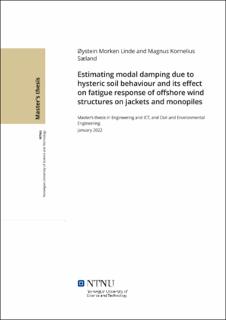| dc.contributor.advisor | Kaynia, Amir M. | |
| dc.contributor.author | Sæland, Magnus Kornelius | |
| dc.contributor.author | Linde, Øystein Morken | |
| dc.date.accessioned | 2022-10-08T17:19:50Z | |
| dc.date.available | 2022-10-08T17:19:50Z | |
| dc.date.issued | 2022 | |
| dc.identifier | no.ntnu:inspera:107175085:22333526 | |
| dc.identifier.uri | https://hdl.handle.net/11250/3024834 | |
| dc.description.abstract | Utmatting er en vesentlig faktor i dimensjoneringen av offshore vindturbiner. Det har blitt vist at jorddemping påvirker utmattingslevetider. Til tross for viktigheten av jorddemping så er det ingen enighet i fagmiljøet hvor stor jorddempingen faktisk er, eller hvordan denne bør beregnes.
Denne oppgaven estimerer modal jorddemping ved å utvikle en numerisk metodikk. Både hysterese og radielldemping er inkludert i beregningen. Effekten av den estimerte jorddempingen ble evaluert ved å utføre flere utmattingsanalyser.
To konstruksjoner ble analysert: En 10 MW monopel-konstruksjon med bare hysterese demping, og en 10 MW jacket-konstruksjon med både hysterese og radielldemping. Det vektede snittet av dempingen i vibrasjonsmodene i vindretningen ble estimert til 3,50% for monopelen og 4,44% for jacketen. Dempingen til side-til-side modene var betydelig lavere. Monopel-konstruksjonens levetid ble økt med 77% da hysterese-jorddempingen ble inkludert. Jacket-konstruksjonen fikk 274% lenger levetid ved å inkludere hysterese-jorddempingene. Ved å i tillegg inkluderer radielldemping ble økningen i levetiden for jacketen ytterligere økt til 285%.
Hysterese dempingen ble beregnet ved å bruke forholdet mellom energien i hver mode og tilhørende energitap i jorden. Energitapet ble beregnet ved å bruke dempingskurver i postprosesseringen av en Abaqus-analyse, som simulerte pel-jordinteraksjonen. En modalanalyse ble implementert for å beregne energien i hver mode og den tilhørende representative forskyvningen av pelene. Lastene som virket på konstruksjonen, ble hentet fra FAST. FAST-modeller med en grunndemping ble etablert for de to konstruksjonene. Deretter ble den estimerte dempingen fra modalanalysen lagt til i ekvivalente moder i FAST. Til slutt ble det utført utmattingsanalyser på de to modellene med grunndemping og ekstra demping fra jord.
En betydelig økning i utmattingslevetiden kan oppnås ved å inkludere jorddemping. Dette kan igjen føre til økt levetid, eller redusert materialbruk. Dermed kan elektrisiteten fra offshore vindturbiner produseres billigere og med lavere karbonavtrykk ved å hensynta jorddempingen. | |
| dc.description.abstract | Fatigue is a vital element in the design of offshore wind turbines. The effect of soil damping has been shown to impact fatigue life. However, no consensus exists on the value of soil damping or how to estimate it.
This thesis estimated the modal soil damping by developing a numerical methodology. Both hysteric and radiation damping were taken into account. The effect of the estimated soil damping was assessed by performing fatigue analyses.
Two structures were analysed: one 10 MW monopile structure, only including hysteric damping, and one 10 MW jacket structure, including hysteric and radiation damping. The weighted average damping in the fore-aft modes was estimated to be 3.50% and 4.44% for the monopile and the jacket -structure, respectively. The damping in the side-to-side modes were much smaller. By including hysteric soil-damping, fatigue life increased by 77% and 274% for the monopile and jacket -structure, respectively. Combined radiation and hysteric soil-damping in the jacket structure gave a 285% increase in fatigue life.
The hysteric damping was estimated by assessing the energy in each mode relative to the energy loss in the soil associated with the mode. Damping curves were used to estimate the energy loss in the soil of an Abaqus analysis simulating the pile-soil interaction. A modal analysis was implemented to find the energy of each mode and the associated representative displacement of the piles. Loads exciting the structure were extracted from FAST. FAST models with baseline damping were established for the two chosen structures. Then the estimated damping values from the modal analysis were added to compatible FAST modes. Finally, a fatigue analysis was carried out on the established models with both baselines and added soil damping.
A substantial increase in fatigue life can be achieved by including soil damping. An increase in fatigue life could, in turn, be exchanged for a longer operational life or reduced material usage. Therefore, a reduction in the cost and carbon footprint per unit of electricity produced by offshore wind turbines can be achieved by including soil damping. | |
| dc.language | eng | |
| dc.publisher | NTNU | |
| dc.title | Estimating modal damping due to hysteric soil behaviour and its effect on fatigue response of offshore wind structures on jackets and monopiles | |
| dc.type | Master thesis | |
